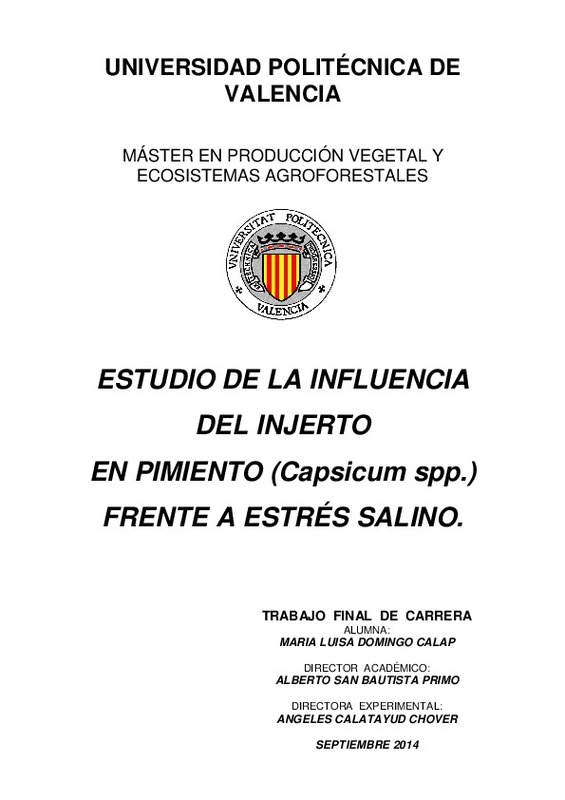JavaScript is disabled for your browser. Some features of this site may not work without it.
Buscar en RiuNet
Listar
Mi cuenta
Estadísticas
Ayuda RiuNet
Admin. UPV
Estudio de la influencia del injerto en pimiento (Capsicum spp.) frente a estrés salino
Mostrar el registro sencillo del ítem
Ficheros en el ítem
| dc.contributor.advisor | San Bautista Primo, Alberto
|
es_ES |
| dc.contributor.advisor | Calatayud Chver, Ángeles
|
es_ES |
| dc.contributor.author | Domingo Calap, María Luisa
|
es_ES |
| dc.date.accessioned | 2015-06-02T10:34:55Z | |
| dc.date.available | 2015-06-02T10:34:55Z | |
| dc.date.created | 2014-09-24 | |
| dc.date.issued | 2015-06-02 | |
| dc.identifier.uri | http://hdl.handle.net/10251/51125 | |
| dc.description.abstract | [EN] Salinity is one of the biggest environmental problems in horticulture. Grafting is presented as a sustainable and respectful technique with the environment. The grafting implementation as an alternative goes through the selection of a good combination of rootstocks and varieties with a good adaptation to stress conditions, in this case salt stress, with an optimum production and quality. In this work, 6 combinations of pepper genotypes (Capsicum spp.) were analyzed: the commercial variety Adige, the accessions A5 and A7 and the graft of the cultivar variety onto itself, as well as onto each of the rootstocks used. These genotypes were studied both, in the germination phase and in the vegetative growth phase, under salinity conditions, using different salinity treatments with different electric conductivity (CE). In order to evaluate the salinity influence on the germination of the used genotypes, a germination essay of them was done first of all. With the objective of evaluating the graft influence over salinity stress, in this study different vegetative parameters were analyzed: plant height, leaves dry weight, stem dry weight, root dry weight and the ratio ((leaves dry weight+ stem dry weight)/ root dry weight); as well as the osmotic potential and the photosynthesis to evaluate the salinity tolerance to the different studied genotypes. As conclusion, taking into account the results, the graft presents better results compared to the ungrafted plants in every cases. The best results, are obtained with the combination Adige/A5. For this reason, the accession A5, could be select to use in breeding programs to improve the salt stress in pepper. For that, is necessary to realize more experiments to understand their physiological and agronomic behavior. | es_ES |
| dc.description.abstract | [ES] La salinidad es uno de los mayores problemas medio ambientales al que tienen que hacer frente los cultivos. El injerto se presenta como una técnica sostenible y respetuosa con el medio ambiente. La implementación del injerto como una alternativa pasa por la selección de una buena combinación patrón/variedad que tenga una buena adaptación a los estreses, en este caso salino, con una óptima producción y calidad. En este trabajo se analizaron 6 combinaciones de genotipos de pimiento (Capsicum spp): la variedad comercial Adige, las accesiones A5 y A7 y el injerto de la variedad cultivada sobre si misma, así como sobre cada uno de los patrones empleados. Estos genotipos se estudiaron tanto en fase de germinación como en fase de crecimiento vegetativo bajo condiciones de estrés salino, empleando diferentes tratamientos salinos a distintas conductividades eléctricas (CE). Para evaluar la influencia de la salinidad sobre la germinación de los genotipos empleados en el estudio, en primer lugar se llevó a cabo un ensayo de germinación de los mismos. Con el objetivo de evaluar la influencia del injerto frente al estrés salino, en este trabajo se estudiaron distintos parámetros vegetativos: altura de la planta, peso seco de las hojas, peso seco del tallo, peso seco de las raíces y el ratio ((peso seco hojas+peso seco tallo)/peso seco raíces); así como el potencial osmótico y la fotosíntesis, para poder evaluar la tolerancia a la salinidad de los distintos genotipos estudiados. De los resultados se concluye, que en todos los casos, el injerto presenta mejores resultados frente a las plantas sin injertar, siendo la combinación Adige/A5 la que mejores resultados presenta. Es por ello, por lo que se podría seleccionar la accesión A5 para su uso en mejora de pimiento frente a estrés salino, siempre y cuando se realizasen estudios más exhaustivos para conocer mejor su comportamiento a nivel fisiológico y agronómico | es_ES |
| dc.format.extent | 70 | es_ES |
| dc.language | Español | es_ES |
| dc.publisher | Universitat Politècnica de València | es_ES |
| dc.rights | Reconocimiento - No comercial - Sin obra derivada (by-nc-nd) | es_ES |
| dc.subject | Injerto | es_ES |
| dc.subject | Pimiento | es_ES |
| dc.subject | Estres salino | es_ES |
| dc.subject | Graft | es_ES |
| dc.subject | Pepper | es_ES |
| dc.subject | Salt stress | es_ES |
| dc.subject.classification | PRODUCCION VEGETAL | es_ES |
| dc.subject.other | Máster Universitario en Producción Vegetal y Ecosistemas Agroforestales-Màster Universitari en Producció Vegetal i Ecosistemes Agroforestals | es_ES |
| dc.title | Estudio de la influencia del injerto en pimiento (Capsicum spp.) frente a estrés salino | es_ES |
| dc.type | Tesis de máster | es_ES |
| dc.rights.accessRights | Abierto | es_ES |
| dc.contributor.affiliation | Universitat Politècnica de València. Servicio de Alumnado - Servei d'Alumnat | es_ES |
| dc.description.bibliographicCitation | Domingo Calap, ML. (2014). Estudio de la influencia del injerto en pimiento (Capsicum spp.) frente a estrés salino. http://hdl.handle.net/10251/51125 | es_ES |
| dc.description.accrualMethod | Archivo delegado | es_ES |






